In an effort to help consumers make healthier decisions and to address the UK’s obesity crisis, the calorie labelling regulations for food businesses in the out-of-home sector are now underway. These regulations require all major caterers to provide calorie information alongside dishes.
For Pelican clients, the good news is that our menu management module within the Pelican Pi software suite, Piranha, can help do some of the work for you.
Who must comply with the calorie regulations?
Any business with 250 or more employees (including part-timers) that sells non-prepacked food or drink across England is now required to display calorie counts for meals on their menus and websites.
Most large hospitality businesses were affected, as well as universities, contract caterers and most franchise businesses to update their menus, to help consumers make healthier food choices. There are some notable exceptions, including schools and colleges (providing education to pupils under the age of 18), prisons, hospitals and care homes that will not need to comply.
What are the requirements?
Foodservice operators now need to display the number of calories (kcal), and the energy content, per portion, along with a reminder on the menu that an adult should consume no more than 2,000 calories per day.
The calorie information displayed needs to include all components of a dish, such as tomato ketchup in a burger bun, dressings included in a salad dish, or mayonnaise in a fish finger wrap. You do not need to consider customer-added condiments, such as coffee syrups, ketchup or mayonnaise, which are added after purchase.
There are some exceptions, for example, there is no need to provide calorie information for special menu items that appear for less than 30 consecutive days, and a total of 30 days in any year.
What calorie information and processes do you need to implement?
Information about the number of calories for an ingredient can come from manufacturers and suppliers or from standard reference data such as McCance & Widdowson’s Composition of Foods Integrated dataset (CoFIDs) (gov.uk)
The legislation requires organisations to develop and implement processes to ensure that calorie information is as accurate as possible, including a system that allows dishes to be reproduced consistently every time they are made.
To cope with processing and ingredient variations, and ingredient substitutions, a tolerance of plus or minus 20% is considered an acceptable margin of difference between actual and declared calorie values.
Whatever method you use for calculating ingredient and dish calories, it is sensible to keep records of how information has been sourced and calculated, should enforcement teams want to know in future.
Hello Piranha! We have a menu management system to help you comply
Piranha is Pi’s menu management module that provides menu engineering tools for caterers and chefs and allows key ingredient information to be gathered, including allergen and nutrition information.
Allergen and nutrition data are requested by the Pelican team directly from suppliers that you use via Pelican. The system allows you to view allergen and nutritional data at the product or recipe level! You can then download this key nutrition and allergen information to share with your customers if required.

Piranha: Best practices for accurate calorie calculating
1. Make sure your ingredient list is accurate – check that the items in your recipe are the ones that are actually being used! Ensure that your team reviews your recipes regularly to ensure that it remains correct.
2. Make sure that quantities in the recipe reflect how the dish is being prepared. If your chefs veer away from following the recipe, then your cost, allergen, calorie and nutritional information will be wrong. Ensure that portion control measures are being used.
3. Ensure that you enter the number of portions that the recipe produces and the weight of a portion of the finished dish and add this information in the ‘yield per recipe/portion’ box in Piranha (Whilst this does not affect the portion nutritional information, it will affect the per 100g nutritional information).
4. Use ingredient weight (g) and volume (ml) used in the recipe to improve accuracy and prevent potential errors from occurring.
5. Remember to include any cooking fats in your recipe such as oils and butter as these products have significant calorific values.
For more on the regulations (gov.uk): https://bit.ly/3MpojDM
We are here to help
If your business is impacted by this legislation and you’d like to learn more about Pi’s solutions, including the Piranha menu management module, email us at hello@pelicanprocurement.co.uk to book your personalised demo.









